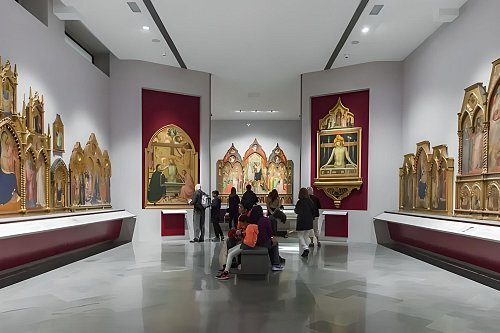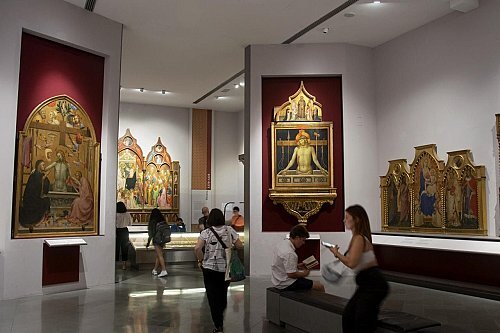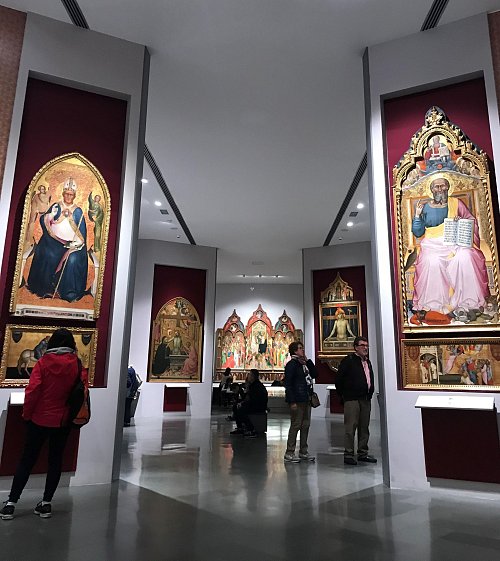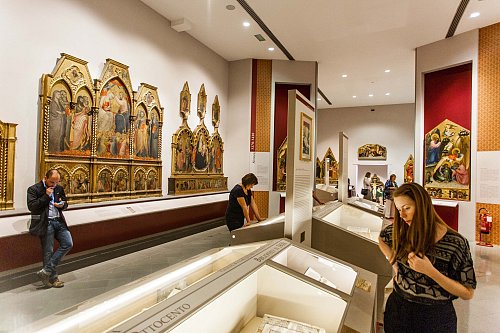Salões do Gótico Tardio

Florença entre 1370 e 1430
O primeiro andar da Accademia (ou segundo, dependendo da sua localização) é certamente menos movimentado do que o piso térreo. Completamente reorganizado em 2013, este nível é dedicado a uma coleção de pinturas florentinas do final do século XIV, de 1370 a 1420. Com nova iluminação, a atmosfera não é mais fria, mas sim tranquila e encantadora — perfeita para apreciar as obras-primas do gótico tardio florentino que retornaram recentemente após restauração.

Vestíbulo
A visita ao primeiro andar começa com obras de arte que expressam a religiosidade da Florença do final do século XIV. No pequeno vestíbulo, encontram-se alguns painéis de Jacopo di Cione e uma requintada Madona com o Menino e Fundo Dourado, de Don Silvestro di Gherarducci.
De grande pathos é o “Massacre dos Inocentes”, da oficina de Jacopo di Cione. Esta obra provém do mosteiro de São João Evangelista Boldrone, em Florença: três episódios da infância de Cristo num único painel. O registo superior apresenta um comovente “massacre dos inocentes”, narrado com grande detalhe através das roupas e expressões das mães, aqui vistas a tentar salvar os seus filhos já mortos ou a chorá-los, enquanto alguns parecem ter sido colocados em atividades com um pincel conhecido também pela sua simpatia. No registro inferior, da esquerda para a direita, está A Adoração dos Magos e A Fuga para o Egito, pintada com muita vida para que seu valor didático pudesse ser facilmente apreciado pelas massas analfabetas. Os três magos, as mulheres e os soldados são retratados com roupas ricas, enquanto uma pequena figura patrona está diante de São. Atrás dos Magos, é possível identificar uma serva que segura um falcão com uma venda nos olhos, um dos motivos comuns encontrados em cenas de caça dos nobres florentinos.
A “Madonna da Humildade”, de Silvestro Gherarducci, é muito gentil. Ela não está entronizada no alto de um grande trono, mas sentada no chão sobre algumas almofadas. O termo latino para humildade tem suas raízes na palavra humus, que significa terra. A Virgem Maria segura o Menino gentilmente, olhando para o seio de sua mãe em um gesto. Don Silvestro Gherarducci viveu no mosteiro camaldulense de Santa Maria degli Angeli, em Florença, e trabalhou como pintor de pequenos quadros. Os relevos produzidos com punções abundam no delicado manto e na requintada borda ultramarina do manto, um recurso que transmite preciosidade, conferindo à obra uma aura de luxo e perfeição técnica.

Salão principal
Na sala central, os visitantes podem ver grandes encomendas das guildas florentinas e a riqueza dos retábulos produzidos no final do século XIV e início do século XV. As dimensões socioeconômicas e devocionais da sociedade florentina são ilustradas através destes grandes retábulos. Evocando a refinada arquitetura gótica, estes vastos retábulos são rodeados por pináculos dourados, torres, pilares e santuários. Quando a moda começou a ser um sinal de distinção, as roupas dos santos nas obras pintadas também se tornaram mais elegantes — até mesmo principescas —, como resultado do número crescente de figuras espremidas em composições que se tornaram mais lotadas. Alguns dos artistas mais importantes em exposição no salão central incluem Giovanni del Biondo, Mariotto di Nardo, Spinello Aretino e obras de Lorenzo Monaco.
Os dois patronos das guildas são o que se vê ao entrar: São João Evangelista, à direita, é retratado em triunfo sobre as alegorias da ganância, do orgulho e da luxúria, servindo como santo padroeiro da Guilda da Seda. Abaixo desta figura, o brasão pode ser visto claramente; no centro está um portão que simboliza onde a guilda tinha sua sede na Via Por Santa Maria e ressalta seu voto de proteger e manter em segredo os segredos relativos à produção de seda — segredos transmitidos de um membro para outro em círculos fechados. Para completar o lado esquerdo, destaca-se o painel de São Martinho com seu emblema, uma taça representada na pintura da predela, que fez do santo o padroeiro dos vinicultores. A forma vertical esguia combina bem com outros detalhes verticais, como as pilastras da Igreja de Orsanmichele, onde os artefatos foram financiados com dinheiro da guilda.
Um dos retábulos mais intricados e magníficos é da autoria de Giovanni del Biondo; apresenta a Anunciação rodeada pelo Pai que abençoa, um coro de anjos e vários santos localizados em diferentes pináculos do altar. É uma peça muito grande que provém do convento de Santa Maria Novella, em Florença, onde adornava uma capela funerária dedicada especificamente à Virgem da Anunciação. Um grande número de santos em roupas ricas em ambos os lados do painel central — facilmente identificáveis pelos nomes inscritos na base — foram retratados. Devido ao analfabetismo generalizado entre os espectadores e patronos, com exceção de alguns clérigos, notários e aristocratas, uma linguagem simples era crucial para comunicar a todos os temas retratados numa pintura. Os pintores, portanto, seguiam rigorosamente o seu repertório específico de símbolos para indicar o martírio de cada santo (incluindo objetos, gestos e cores particulares), de modo que os atributos representados nos santos fossem sinais bem reconhecidos que os identificassem.
São João Batista é identificado por um cabelo de camelo e uma cruz, São Pedro com chaves, Maria Madalena com cabelos esvoaçantes e vestimenta vermelha, Santa Catarina com uma roda representando seu martírio.
A bela Anunciação, de Lorenzo Monaco, provém do mosteiro da Abadia Florentina, em frente ao Bargello. Inicialmente, este tríptico destinava-se ao altar da igreja paroquial de São Proculus, que já não existe. Entre os santos aqui representados, é possível reconhecer Catarina, Antônio Abade, Proculus e Francisco de Assis, com Deus Pai aparecendo na cúspide. A composição é animada pela representação graciosa das figuras: O arcanjo Gabriel em voo contrasta com o gesto ansioso da Virgem vestida com ricos mantos. À direita do arcanjo (adornado com uma auréola brilhante e chamas divinas na testa), está Santo Antônio - figura vestida com uma túnica que chega até os tornozelos - segurando um cajado sob um braço e um livro na outra mão; ao seu lado, há um pequeno leitão selvagem a seus pés. Isso deriva da tradição dos monges antonianos, que criavam porcos e usavam sua gordura como unguento para pacientes afetados por feridas dolorosas e ardentes, conhecidas como “herpes zoster”. Só muito recentemente uma restauração meticulosa revelou as cores vibrantes usadas por Lorenzo Monaco.
Um políptico notável produzido em 1401 por um grupo de artistas, incluindo Spinello Aretino, Niccolò di Pietro Gerini e Lorenzo di Niccolò di Martino, é interessante. A obra deles, da igreja de Santa Felicita, em Florença, é um exemplo por excelência da prática da época, que via pintores se unirem em parcerias que eram verdadeiras “empresas” ou “oficinas” O provável líder entre eles foi Spinello Aretino, que concebeu o tema “A Virgem Coroada”, que é a Rainha do Céu recebendo sua coroa do Redentor. Esse rico simbolismo rapidamente se tornou uma metáfora da glória triunfante da Igreja. Frequentemente presente em retábulos de igrejas monásticas femininas, ele prega que essas freiras também serão recompensadas com a felicidade celestial por sua devoção constante, envolvendo orações e penitências. O que mais chama a atenção nesta pintura é a grande variedade de instrumentos musicais colocados aos pés dos anjos ao lado das Virgens — tambores, gaitas de foles, outros instrumentos de sopro — todos retratados de forma bastante realista, sendo tocados em algum lugar, o que dá vida à cena!
No final da sala, uma magnífica obra-prima têxtil dá as boas-vindas aos visitantes. A vestimenta sagrada, conhecida como paliotto, recebe os espectadores com a sua antiga glória, agora exposta nas paredes como um vasto tecido bordado — os seus fios de seda policromada dourados e prateados outrora brilhavam no altar-mor da igreja de Santa Maria Novella, em Florença. Executada por Jacopo Cambi em 1336, esta obra personifica a grande consideração que o bordado tinha em Florença: durante o século XIV, este artesanato era muito apreciado muito além das fronteiras da República Florentina. Na parede oposta, encontra-se um grande retábulo recentemente restaurado. A atenção é imediatamente atraída para ele devido aos tons vibrantes restaurados ao seu brilho original em “A Coroação da Virgem”, de Rossello di Jacopo Franchi, rodeada por santos e anjos do mosteiro de Santa Maria delle Campora, em Florença. A parte de trás das três seções principais do políptico mostra uma decoração em mármore, revelando que o retábulo era para ser visto por trás. As cúspides são adornadas com anjos serafins em azul e querubins em vermelho.

Gótico Internacional
Na escadaria final. Duas cruzes pintadas do início do século XV delimitam-na. A secção final do museu contém a Sala do Gótico Internacional.
A coleção é rica em obras-primas de Lorenzo Monaco, proeminente pintor florentino que atuou na virada dos séculos XIV e XV. Ele era monge no mosteiro florentino de Santa Maria degli Angeli, da Ordem Camaldulense, e também um talentoso miniaturista que trabalhava principalmente na iluminação de códices.
No salão também se encontra a Madona com o Menino e Santos, de Gherardo Starnina, um dos principais representantes do estilo gótico internacional em Florença. Embora fosse florentino de nascimento, permaneceu por um longo período na corte real de Valência, na Espanha. Foi durante esse período que desenvolveu um estilo figurativo mais vívido e individualista que, ao regressar a Florença pouco depois de 1400, exerceu uma forte influência nos seus contemporâneos, incluindo Lorenzo Monaco. As figuras ágeis nas suas pinturas altamente trabalhadas exalam um ar perfumado de fervor religioso: azuis perolados, rosas e violetas pintam formas delicadas, com uma luz que parece emanar delas, tons divinos luminosos dentro de reinos celestiais.
Neste espaço, é possível ver o desenvolvimento da forma do retábulo: de polípticos complexos cravejados de pináculos e remates a painéis retangulares. Entre eles está uma obra recentemente atribuída ao Mestre de Santa Inês, que, apesar de não ser tão famoso em Florença, trabalhava em estreita colaboração com Agnolo Gaddi e Lorenzo Monaco no início do século XIV. Criada nas oficinas de alguma comunidade dentro do Palazzo em Florença, esta obra seria uma alegoria da Virtude — especificamente da Justiça. Ivo dispensa justiça à sua direita como patrono dos pobres, órfãos e viúvas, que se dedicava aos pobres com esmolas à esquerda, passando por doadores ricos e bem vestidos à sua direita. Observe os chapéus e coletes de brocado dos nobres em contraste com as roupas pobres ou meias dos órfãos. Uma canonização de 1366 decidiu que São Ivo deveria ser representado como um advogado, sublinhando sua função como juiz eclesiástico, bem como seu compromisso com a proteção dos direitos dos menos privilegiados.
Dentro do salão, você terá a oportunidade de assistir ao vídeo muito cativante descrito acima, que mostra em sequência, com grande precisão e seguindo palavra por palavra, as etapas das técnicas de pintura a têmpera em painel, de acordo com o “Livro da Arte” de Cennino Cennini, pintor e miniaturista florentino do final do século XIV. Este vídeo explica como é feito um pequeno modelo de retábulo, desde a preparação da madeira e o douramento até a pintura final com têmpera de ovo. O termo políptico (do grego Polu- muitos e ptyche- dobras) refere-se a uma pintura composta por vários painéis pintados dispostos juntos em uma composição de moldura. Quando uma obra é dividida em três seções, é chamada de tríptico. Normalmente, essas pinturas apresentavam elementos decorativos, como cúspides na parte superior ou pilastras nas laterais, e repousavam sobre um “degrau” pintado, chamado “predella”. Os carpinteiros uniam habilmente as diferentes partes dos retábulos antes de passá-los aos pintores para o douramento e a pintura. Uma prática que remonta à antiguidade ainda está muito viva em Florença hoje em dia, graças às encantadoras oficinas de restauração de arte!
